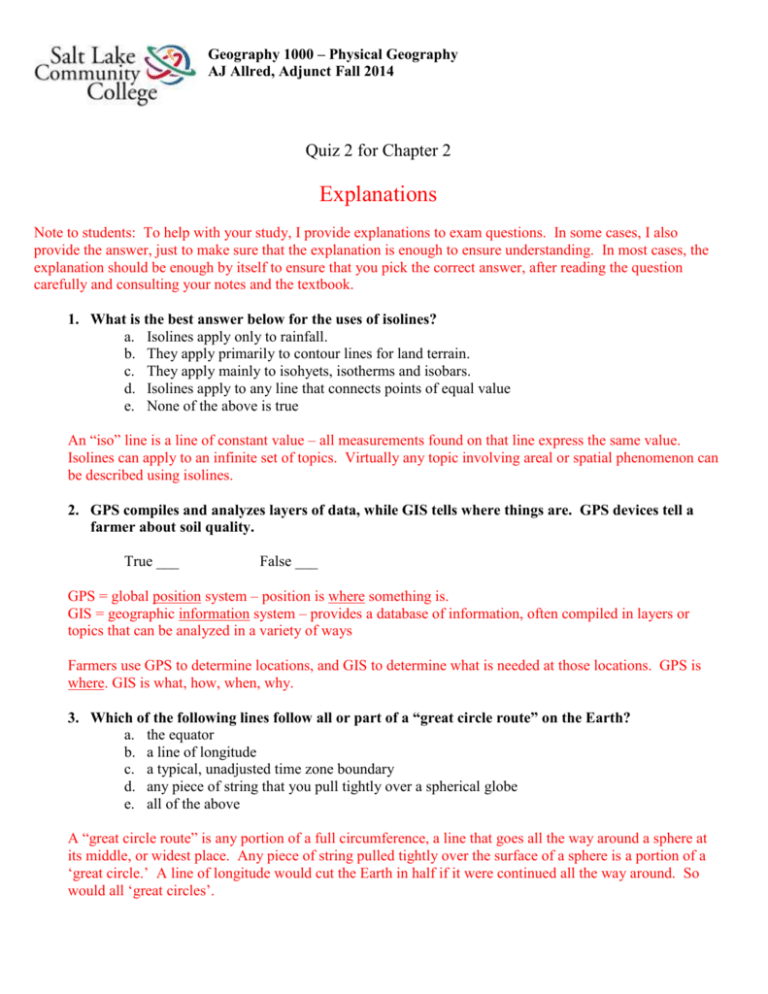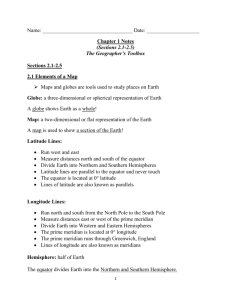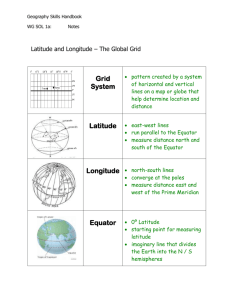Geography 1000
advertisement

Geography 1000 – Physical Geography AJ Allred, Adjunct Fall 2014 Quiz 2 for Chapter 2 Explanations Note to students: To help with your study, I provide explanations to exam questions. In some cases, I also provide the answer, just to make sure that the explanation is enough to ensure understanding. In most cases, the explanation should be enough by itself to ensure that you pick the correct answer, after reading the question carefully and consulting your notes and the textbook. 1. What is the best answer below for the uses of isolines? a. Isolines apply only to rainfall. b. They apply primarily to contour lines for land terrain. c. They apply mainly to isohyets, isotherms and isobars. d. Isolines apply to any line that connects points of equal value e. None of the above is true An “iso” line is a line of constant value – all measurements found on that line express the same value. Isolines can apply to an infinite set of topics. Virtually any topic involving areal or spatial phenomenon can be described using isolines. 2. GPS compiles and analyzes layers of data, while GIS tells where things are. GPS devices tell a farmer about soil quality. True ___ False ___ GPS = global position system – position is where something is. GIS = geographic information system – provides a database of information, often compiled in layers or topics that can be analyzed in a variety of ways Farmers use GPS to determine locations, and GIS to determine what is needed at those locations. GPS is where. GIS is what, how, when, why. 3. Which of the following lines follow all or part of a “great circle route” on the Earth? a. the equator b. a line of longitude c. a typical, unadjusted time zone boundary d. any piece of string that you pull tightly over a spherical globe e. all of the above A “great circle route” is any portion of a full circumference, a line that goes all the way around a sphere at its middle, or widest place. Any piece of string pulled tightly over the surface of a sphere is a portion of a ‘great circle.’ A line of longitude would cut the Earth in half if it were continued all the way around. So would all ‘great circles’. The “circle of illumination” also cuts the Earth in half, because the sun can only shine on half of the Earth at a time. The boundary of solar illumination represents a ‘great circle’ that separates the sunny half of the Earth from the “night” half of the Earth. 4. A region that spans six time zones is: a. About 90 degrees of the earth’s circumference b. Roughly 33 percent of the earth’s circumference c. About 90 degrees of latitude d. About 6,000 miles of distance at any latitude on the surface of the Earth e. Answers ‘a’ and ‘c’ above are both correct Going east and west on the Earth we mark time zones at major lines of longitude every 15°. So, a circle of 360 degrees would contain 24 times zones, each worth 15° of angle. 360/15 = 24 hours in a day, or 24 time zones. So, 90° of angle divided by 15° yields 6 time zones: 90/15 = 6. It takes the earth six hours to turn or rotate through six time zones or 90° of angle. 5. In Utah, the days start getting shorter on September 21, which is the beginning of Autumn (Fall). True ___ False ___ The longest day of the year for everywhere north of the equator is about June 20th which is the summer ‘solstice’. In the northern hemisphere, including Utah, the days start getting shorter after June 20th or 21st each year. September 20th or 21st represents the Fall ‘equinox’ when days and nights for the whole world are 12 hours each. The shortest day of the year for Utah and the rest of northern hemisphere is December 21 – the winter ‘solstice’. After December 20th or 21st, each day gets longer until about June 20th. Meanwhile, March 20th or 21st is the spring ‘equinox’ when days and nights are the same length, just as in September, six months later. In Utah, the shortest day (in December) provides about nine hours of sunshine and 15 hours of night. The longest day (in June) reverses that, with about 15 hours or sunshine. 6. By simple interpolation, which of the following is the best estimate as to the surface speed of the earth’s rotation at about 30 degrees south latitude? a. 1037 mph b. 1,000 mph c. 670 mph d. 130 mph e. none of the above If the earth’s surface speed of rotation at the Equator is about 1,000 miles per hour (one time zone per hour 24 hours per day), then rough interpolation would show about 500 mph at 45° north or south latitude. Thirty degrees south latitude is about 1/3 of the distance to the south pole. Simple interpolation would suggest a 1/3 loss of rotation speed. At the very simplest, that speed would be have to be somewhere in between 500 mph and 1,000 mph. Only answer ‘c’ fits that interpolation. 7. Summertime warm weather results from the Earth being closer to the Sun in July. True ___ False ___ The distance between Earth and Sun does vary, but the apogee (greatest distance from Earth to Sun) and perigee (closest) is not as important to Earth climates as is the inclined axis of rotation. In fact, the Earth is actually furthest from the sun in July of each year. 8. If the time is 9:00 AM in Salt Lake City, then what time is it at 15° East longitude? a. 12:00 AM b. 12:00 PM c. 5:00 PM d. This is a trick question, because time zones are measured in miles or kilometers, not degrees. e. None of the above is a good answer because the latitude for 15° East was not provided in the question Utah is in the time zone that goes from 105°W to 120°W, which is seven hours west of Greenwich (GMT) - 105°/15° = 7 hours. Positions to the west are behind or earlier than positions to the east. A location at 15°E is one hour east of London (Greenwich), for a total of eight hours difference between SLC and 15°E longitude. Because the east gets the Sun before the west, the eight-hour difference means that 15° E is eight hours later in the day than Salt Lake City. So, add eight hours to 9:00 AM and get 5:00 PM at 15°E. 9. Which of the following map scales represents objects at their largest size? a. 1:100,000 b. 1:1,000,000 c. 1:24,000 d. 1:10,000 e. 1:50,000 Intuitively, a 1:1 map would be full size. Any ratio less than that would be smaller than full size. So, a 1:1,000,000 would indicate the real world being one million times bigger than the map. On the other end of the scale, a 1:10,000 represents a map that is closer to full size than any of the other options. 10. A map with a fractional scale of 1/5,280 represents the same scale as: a. One inch = a mile b. One foot on the map is equal to 63,360 feet on the real world c. One foot = a mile d. None of the above is correct e. Answers ‘a’ and ‘b’ above are both correct Fractional scales should all be interpreted in “apples to apples” terms. Convert one side of the fraction to the same terms as the other side. So, which of the answers in question #10 is “apples to apples?” Well, there are 5,280 feet in a mile. So, a fractional map scale of one foot = a mile is the same as saying: “one foot = 5,280 feet”. That would read the same as 1/5,280, which is also like saying: One apple = 5,280 apples or One inch = 5,280 inches or One foot = 5,280 feet So, if one foot = 5,280 feet then the map scale could be said to have a scale of: One foot = one mile because a mile contains 5,280 feet. So, just be sure to convert all terms to the same type of measurement: “inches to inches”, “miles to miles”. 11. Of the following, which is NOT considered a map essential? a. title b. date c. color d. legend e. scale Color is optional. All of the other items are considered vital or essential to a good map. 12. Map ‘equivalence’ portrays accurate relative size although it ________. a. turns parallels into longitudes (meridians) b. renders the poles as lines c. changes time zones to the wrong value d. distorts shapes e. All of the above Equivalence means that areas are the same size from place to place. Typically, flat maps have the meridians stretched near the top and bottom (near the poles) because we usually don’t have much interest in desolate areas at extreme latitudes. So, equivalence maps show areas in proper size to each other, but shapes get badly distorted to make up the difference. So, when sizes are correct, shapes are wrong. When shapes are correct, areas are wrong. 13. The main reason for interrupting a map projection is to ________. a. improve portrayal of the oceans b. provide a stereoscopic 3-D view c. make maps compatible with air photos d. show continents with minimum distortion e. save ink during printing The process of converting a spherical object to a flat piece of paper is like trying to peel an orange and make all the pieces fit together and lay flat – impossible! For example, flattening an orange peel would cause the edges to tear. An “interrupted” map splits or divides through the middle of oceans because we don’t care about the ocean as much as we care about land areas. 14. The best overall representation of the entire Earth is probably a: a. comprehensive conic map projection b. Universal Transverse Mercator projection c. bulky desktop plastic globe d. flat paper or planar projection that “touches” the globe at one point of tangency e. A compromise projection that is partially conformal and partially equivalent, such as a Robinson projection. Converting a sphere to a flat plane is like pounding on an orange peel until it is flat. The result is a distorted, torn, inaccurate comparison to a sphere. All flat maps contain vast distortions in distance, shape, and/or direction. Maps symbols usually don’t look like the objects on Earth they represent. Overall, an ordinary desktop globe made of paper or plastic is the best compromise for comparing distances, directions, sizes and shapes. Of course, all maps are badly distorted in some way. The biggest problem with a globe is that it is far, far too small. Otherwise, a globe does a great job or preserving size, shape, direction and distance. 15. A ‘thematic map’ provides all of the following benefits except ________________. a. Information on a specific topic b. Accurate density or distribution of data within each area c. A map scale d. A legend describing the topic shown in the map e. Location, in latitude, longitude or some other datum or projection Think of ‘theme’ or topic. Thematic maps show the distribution of people, farm crops, education - - almost any topic you like. Area maps tend to generalize when whole areas are symbolized or colored the same. The truth is, within areas there is also variation. For instance, in the United States a large portion of people live near coasts and/or in large cities, while many areas are sparsely populated. So, a density map for the USA will show an average for the whole nation, with gross inaccuracy for any particular location within the national boundary. 16. Which of the following pairs of remote sensing devices can identify ships on the ocean surface and submarines under water? a. radar and sonar b. sonar and passive microwave c. passive microwave and GIS d. thermal infrared and orthophoto imagery e. Landsat and GPS Radar is “radio direction and ranging”. Radio waves sent out from a transmitter, and then received when that signal reflects or ‘bounces’ back to a receiver at the same station. Radar is for finding or tracking objects in the air, or on the surface of the ground. Radar is not effective underground or underwater. Sonar is “sound navigation and ranging”. Sonar sends out sound waves that can travel easily through water. So, submerged objects can be located or tracked by sonar. 17. A Mercator projection can preserve shape at higher latitudes by stretching distance between latitudes and longitudes equally. However, preserving shapes results in totally distorting relative sizes. In order to preserve shape at high latitudes, sizes at high latitude become far too large compared to objects near the Equator or central parallel. True ___ False ___ The famous Mercator system of maps is created conceptually by wrapping an imaginary paper all the way around the Earth at the Equator. The ‘paper’ touches the Equator all the way around. The paper forms a cylinder or tube that is open at the poles. Objects near the Equator are fairly accurate in size and shape because they are touching, or close to be exactly at the surface of the map. Higher latitudes become increasingly distorted with distance from the Equator, so that shapes and sizes become meaningless near the poles unless adjustments are made. In fact, the Mercator map type results in north-south meridians being stretched or spread apart instead of converging at the poles. By also commensurately extending distance between latitudes a Mercator map can preserve shapes but at the expense of size. Sizes become totally unrealistic at higher latitudes even though shapes may still look good. 18. The scale of "an inch on the map represents two miles on the surface of the Earth" would be closest to which representative fraction? a. 1:120,000 b. 1:200,000 c. 1:1,000,000 d. 1:60,000 e. 1:12 As described in questions #9 and #10 above, the smallest difference between numbers in a ratio indicates the image or representation closest to reality. So, convert “apples to apples” convert inches to inches. There are 12 x 5,280 = 63.360 inches in a miles, or 126, 720 inches in two miles. So, “an inch compared to 126,720 inches” is closest to 1:120,000 in the options above. 19. A map which focuses on accurate shapes of all of the world’s continents while ignoring oceans would probably be based on which of the following projection types? a. plane projection b. equal area and azimuthal c. interrupted and conformal d. conical and equal area e. very small scale maps Conformal maps preserve shapes. Equivalent maps preserve relative sizes. An interrupted map usually splits the Earth’s surface within oceans, because there isn’t very much of interest out on the oceans. 20. A Mercator map is constructed by projecting the grid of the globe onto a(n) ________. a. flat surface b. cone c. cylinder d. interrupted surface e. circle See explanation to question #17 above.








